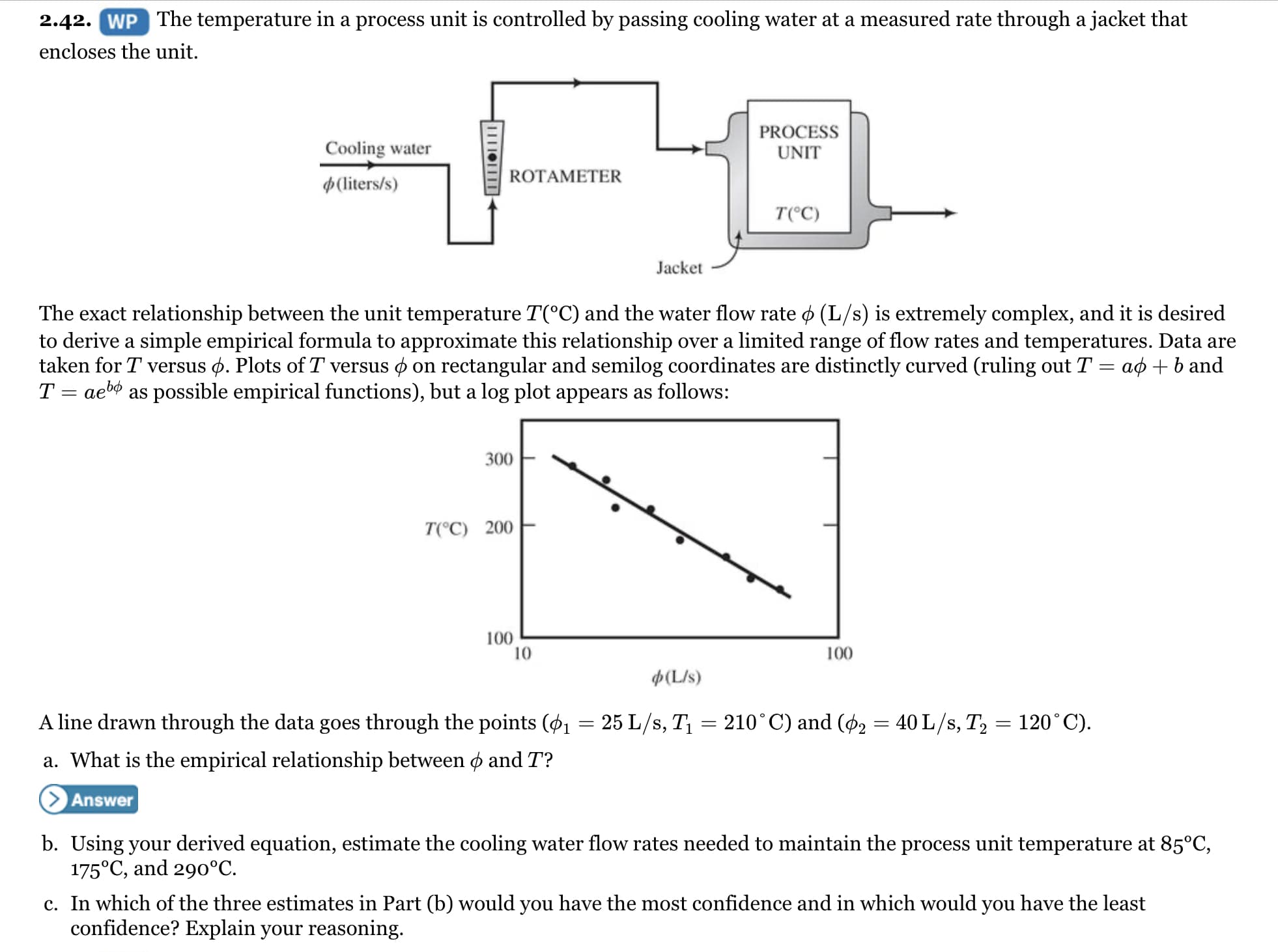2.42. WP The temperature in a process unit is controlled by passing cooling water at a measured rate through a jacket that encloses the unit. Cooling water PROCESS UNIT ROTAMETER p(liters/s) T(°C) Jacket The exact relationship between the unit temperature T(°C) and the water flow rate o (L/s) is extremely complex, and it is desired to derive a simple empirical formula to approximate this relationship over a limited range of flow rates and temperatures. Data are taken for T versus ø. Plots of T versus ø on rectangular and semilog coordinates are distinctly curved (ruling out T = aø + b and T = aebó as possible empirical functions), but a log plot appears as follows: 300 T(°C) 200 100 10 100 p(L/s) A line drawn through the data goes through the points (ø1 = 25 L/s, T = 210°C) and (ø2 = 40 L/s, T, = 120°C). a. What is the empirical relationship between o and T? Answer b. Using your derived equation, estimate the cooling water flow rates needed to maintain the process unit temperature at 85°C, 175°C, and 290°C. c. In which of the three estimates in Part (b) would you have the most confidence and in which would you have the least confidence? Explain your reasoning.
2.42. WP The temperature in a process unit is controlled by passing cooling water at a measured rate through a jacket that encloses the unit. Cooling water PROCESS UNIT ROTAMETER p(liters/s) T(°C) Jacket The exact relationship between the unit temperature T(°C) and the water flow rate o (L/s) is extremely complex, and it is desired to derive a simple empirical formula to approximate this relationship over a limited range of flow rates and temperatures. Data are taken for T versus ø. Plots of T versus ø on rectangular and semilog coordinates are distinctly curved (ruling out T = aø + b and T = aebó as possible empirical functions), but a log plot appears as follows: 300 T(°C) 200 100 10 100 p(L/s) A line drawn through the data goes through the points (ø1 = 25 L/s, T = 210°C) and (ø2 = 40 L/s, T, = 120°C). a. What is the empirical relationship between o and T? Answer b. Using your derived equation, estimate the cooling water flow rates needed to maintain the process unit temperature at 85°C, 175°C, and 290°C. c. In which of the three estimates in Part (b) would you have the most confidence and in which would you have the least confidence? Explain your reasoning.
Introduction to Chemical Engineering Thermodynamics
8th Edition
ISBN:9781259696527
Author:J.M. Smith Termodinamica en ingenieria quimica, Hendrick C Van Ness, Michael Abbott, Mark Swihart
Publisher:J.M. Smith Termodinamica en ingenieria quimica, Hendrick C Van Ness, Michael Abbott, Mark Swihart
Chapter1: Introduction
Section: Chapter Questions
Problem 1.1P
Related questions
Question
The problem that is listed below need to be solved and you may access that problem via viewing them through the attached images in this request. **Question Number #2.42**

Transcribed Image Text:2.42. WP The temperature in a process unit is controlled by passing cooling water at a measured rate through a jacket that
encloses the unit.
Cooling water
PROCESS
UNIT
ROTAMETER
p(liters/s)
T(°C)
Jacket
The exact relationship between the unit temperature T(°C) and the water flow rate o (L/s) is extremely complex, and it is desired
to derive a simple empirical formula to approximate this relationship over a limited range of flow rates and temperatures. Data are
taken for T versus ø. Plots of T versus ø on rectangular and semilog coordinates are distinctly curved (ruling out T = aø + b and
T = aebó as possible empirical functions), but a log plot appears as follows:
300
T(°C) 200
100
10
100
p(L/s)
A line drawn through the data goes through the points (ø1 = 25 L/s, T = 210°C) and (ø2 = 40 L/s, T, = 120°C).
a. What is the empirical relationship between o and T?
Answer
b. Using your derived equation, estimate the cooling water flow rates needed to maintain the process unit temperature at 85°C,
175°C, and 290°C.
c. In which of the three estimates in Part (b) would you have the most confidence and in which would you have the least
confidence? Explain your reasoning.
Expert Solution
This question has been solved!
Explore an expertly crafted, step-by-step solution for a thorough understanding of key concepts.
This is a popular solution!
Trending now
This is a popular solution!
Step by step
Solved in 5 steps with 5 images

Knowledge Booster
Learn more about
Need a deep-dive on the concept behind this application? Look no further. Learn more about this topic, chemical-engineering and related others by exploring similar questions and additional content below.Recommended textbooks for you

Introduction to Chemical Engineering Thermodynami…
Chemical Engineering
ISBN:
9781259696527
Author:
J.M. Smith Termodinamica en ingenieria quimica, Hendrick C Van Ness, Michael Abbott, Mark Swihart
Publisher:
McGraw-Hill Education

Elementary Principles of Chemical Processes, Bind…
Chemical Engineering
ISBN:
9781118431221
Author:
Richard M. Felder, Ronald W. Rousseau, Lisa G. Bullard
Publisher:
WILEY

Elements of Chemical Reaction Engineering (5th Ed…
Chemical Engineering
ISBN:
9780133887518
Author:
H. Scott Fogler
Publisher:
Prentice Hall

Introduction to Chemical Engineering Thermodynami…
Chemical Engineering
ISBN:
9781259696527
Author:
J.M. Smith Termodinamica en ingenieria quimica, Hendrick C Van Ness, Michael Abbott, Mark Swihart
Publisher:
McGraw-Hill Education

Elementary Principles of Chemical Processes, Bind…
Chemical Engineering
ISBN:
9781118431221
Author:
Richard M. Felder, Ronald W. Rousseau, Lisa G. Bullard
Publisher:
WILEY

Elements of Chemical Reaction Engineering (5th Ed…
Chemical Engineering
ISBN:
9780133887518
Author:
H. Scott Fogler
Publisher:
Prentice Hall


Industrial Plastics: Theory and Applications
Chemical Engineering
ISBN:
9781285061238
Author:
Lokensgard, Erik
Publisher:
Delmar Cengage Learning

Unit Operations of Chemical Engineering
Chemical Engineering
ISBN:
9780072848236
Author:
Warren McCabe, Julian C. Smith, Peter Harriott
Publisher:
McGraw-Hill Companies, The